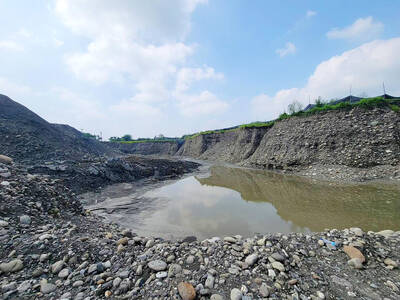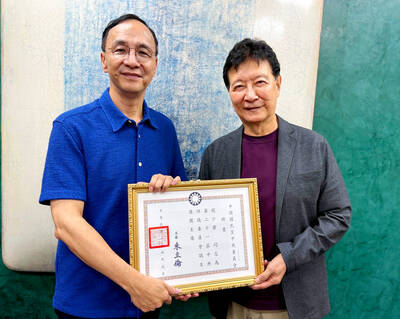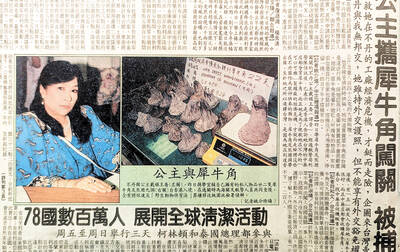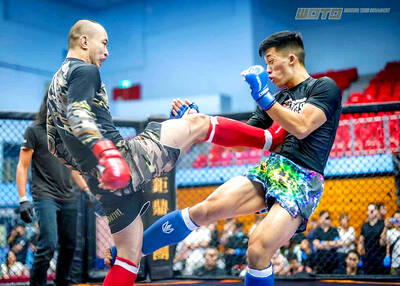Wu Hsiao-hsien (吳效賢), founder of Guts Improv Theater (勇氣即興劇場), says improvisational actors have a saying that one in five performances flop.
But this is where the genre’s excitement lies.
Improvisers have to act, sing or play musical instruments impromptu, which can lead to surprising, hilarious and downright bizarre dialogues and scenes — but also awkward silences and jokes that miss the mark.
“The audience will be adventuring with the improvisers,” says Wu. “They will feel fearful if performers find themselves on the verge of a blunder.”
Established four years ago as Taiwan’s first Mandarin improvisational theater group, Guts Improv Theater presents three forms of unscripted drama for audiences at Taipei’s Comedy Club this weekend.
In Improv Games actors solicit suggestions from the audience for a story to use in five- to 10-minute dramas. In Unscripted Love Story actors stage an hour-long romantic narrative, double the length of the group’s previous long-form dramas, with members of the audience contributing story suggestions. And in Improv Jam those in the audience who are bold enough have the chance to try their luck on stage.
Though actors will be on hand to offer guidance during Improv Jam, short-form improv is no easy task.
“Having to give a sense of the segment’s ending in a 10-minute skit is challenging,” says Wu. “With a longer drama, you have more time to establish your characters and their relationships.”
For Unscripted Love Story musician Jane Lin (林伊真) will compose songs extemporaneously while performers Strawberry Kao (高琇慧), Chang I-hui (張亦暉), Renee Wang (王思為) and Lamen Wang (王志龍) join in with lyrics on the fly.
To make this kind of cooperation possible, improvisers have to spend a great deal of time rehearsing together as a team.
Wu likens improv theater to playing tennis. “You have no idea whatsoever of the playing style your opponent will have, but you still have to work on your returns, serves and other basic skills. It’s the same with improv. We don’t know what our story line will be beforehand, yet we can practice our techniques in improvisation and storytelling.”

Last week the story of the giant illegal crater dug in Kaohsiung’s Meinong District (美濃) emerged into the public consciousness. The site was used for sand and gravel extraction, and then filled with construction waste. Locals referred to it sardonically as the “Meinong Grand Canyon,” according to media reports, because it was 2 hectares in length and 10 meters deep. The land involved included both state-owned and local farm land. Local media said that the site had generated NT$300 million in profits, against fines of a few million and the loss of some excavators. OFFICIAL CORRUPTION? The site had been seized

Next week, candidates will officially register to run for chair of the Chinese Nationalist Party (KMT). By the end of Friday, we will know who has registered for the Oct. 18 election. The number of declared candidates has been fluctuating daily. Some candidates registering may be disqualified, so the final list may be in flux for weeks. The list of likely candidates ranges from deep blue to deeper blue to deepest blue, bordering on red (pro-Chinese Communist Party, CCP). Unless current Chairman Eric Chu (朱立倫) can be convinced to run for re-election, the party looks likely to shift towards more hardline

Sept. 15 to Sept. 21 A Bhutanese princess caught at Taoyuan Airport with 22 rhino horns — worth about NT$31 million today — might have been just another curious front-page story. But the Sept. 17, 1993 incident came at a sensitive moment. Taiwan, dubbed “Die-wan” by the British conservationist group Environmental Investigation Agency (EIA), was under international fire for being a major hub for rhino horn. Just 10 days earlier, US secretary of the interior Bruce Babbitt had recommended sanctions against Taiwan for its “failure to end its participation in rhinoceros horn trade.” Even though Taiwan had restricted imports since 1985 and enacted

Enter the Dragon 13 will bring Taiwan’s first taste of Dirty Boxing Sunday at Taipei Gymnasium, one highlight of a mixed-rules card blending new formats with traditional MMA. The undercard starts at 10:30am, with the main card beginning at 4pm. Tickets are NT$1,200. Dirty Boxing is a US-born ruleset popularized by fighters Mike Perry and Jon Jones as an alternative to boxing. The format has gained traction overseas, with its inaugural championship streamed free to millions on YouTube, Facebook and Instagram. Taiwan’s version allows punches and elbows with clinch striking, but bans kicks, knees and takedowns. The rules are stricter than the